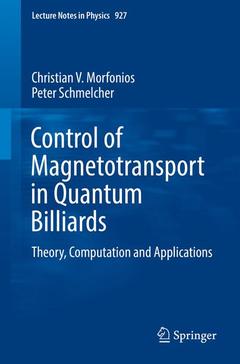Description
Control of Magnetotransport in Quantum Billiards, 1st ed. 2017
Theory, Computation and Applications
Lecture Notes in Physics Series, Vol. 927
Authors: Morfonios Christian V., Schmelcher Peter
Language: English
Subjects for Control of Magnetotransport in Quantum Billiards:
47.46 €
In Print (Delivery period: 15 days).
Add to cart
Publication date: 11-2016
Support: Print on demand
Support: Print on demand
Description
/li>Contents
/li>Biography
/li>Comment
/li>
In this book the coherent quantum transport of electrons through two-dimensional mesoscopic structures is explored in dependence of the interplay between the confining geometry and the impact of applied magnetic fields, aiming at conductance controllability.
After a top-down, insightful presentation of the elements of mesoscopic devices and transport theory, a computational technique which treats multiterminal structures of arbitrary geometry and topology is developed. The method relies on the modular assembly of the electronic propagators of subsystems which are inter- or intra-connected providing large flexibility in system setups combined with high computational efficiency. Conductance control is first demonstrated for elongated quantum billiards and arrays thereof where a weak magnetic field tunes the current by phase modulation of interfering lead-coupled states geometrically separated from confined states. Soft-wall potentials are then employed for efficient and robust conductance switching by isolating energy persistent, collimated or magnetically deflected electron paths from Fano resonances. In a multiterminal configuration, the guiding and focusing property of curved boundary sections enables magnetically controlled directional transport with input electron waves flowing exclusively to selected outputs. Together with a comprehensive analysis of characteristic transport features and spatial distributions of scattering states, the results demonstrate the geometrically assisted design of magnetoconductance control elements in the linear response regime.
After a top-down, insightful presentation of the elements of mesoscopic devices and transport theory, a computational technique which treats multiterminal structures of arbitrary geometry and topology is developed. The method relies on the modular assembly of the electronic propagators of subsystems which are inter- or intra-connected providing large flexibility in system setups combined with high computational efficiency. Conductance control is first demonstrated for elongated quantum billiards and arrays thereof where a weak magnetic field tunes the current by phase modulation of interfering lead-coupled states geometrically separated from confined states. Soft-wall potentials are then employed for efficient and robust conductance switching by isolating energy persistent, collimated or magnetically deflected electron paths from Fano resonances. In a multiterminal configuration, the guiding and focusing property of curved boundary sections enables magnetically controlled directional transport with input electron waves flowing exclusively to selected outputs. Together with a comprehensive analysis of characteristic transport features and spatial distributions of scattering states, the results demonstrate the geometrically assisted design of magnetoconductance control elements in the linear response regime.
Introduction.- Electrons in mesoscopic low-dimensional systems.- Coherent electronic transport: Landauer-Büttiker formalism.- Stationary scattering in planar confining geometries.- Computational quantum transport in multiterminal and multiply connected structures.- Magnetoconductance switching by phase modulation in arrays of oval quantum billiards.- Current control in soft-wall electron billiards: energy-persistent scattering in the deep quantum regime.- Directional transport in multiterminal focusing quantum billiards.- Summary, conclusions, and perspectives.
Christian Morfonios studied physics at Athens University and received his Ph. D. at Hamburg University in the field of electronic transport in mesoscopic structures. Having developed an expertise in computational wave transport, his main current focus is the analysis and simulation of mechanisms underlying the control of electronic conductance in nanoscale circuits.
Gives formulas for computational quantum transport in multiterminal and multiply connected structures Explains magnetoconductance switching in the deep quantum regime Discusses directional transport in nanostructures
© 2024 LAVOISIER S.A.S.




